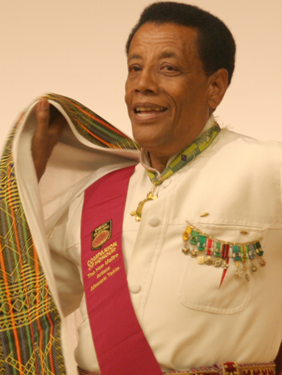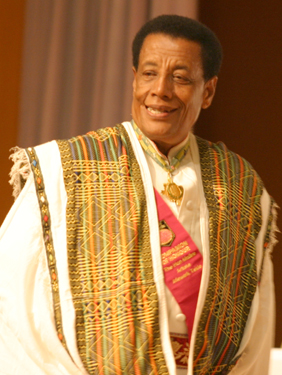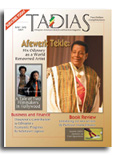 Maitre Afewerk Tekle speaking at Stanford University's annual Pioneers Forum organized by the Stanford Ethiopian Student Union on March 7, 2004. (Photo: Tadias Archive)
Maitre Afewerk Tekle speaking at Stanford University's annual Pioneers Forum organized by the Stanford Ethiopian Student Union on March 7, 2004. (Photo: Tadias Archive)
Publisher’s Note: It was the first time since the mid-1960’s that Maitre Afewerk Tekle had traveled to the United States to talk about his award-winning artwork. As the featured speaker for the annual Pioneers Forum organized by the Stanford Ethiopian Student Union, Maitre Afewerk shared his personal journey with diverse audience from Stanford and the larger Bay Area Ethiopian-American community on March 7, 2004. Here is our story from Tadias archive.
By Tseday Alehegn
Speaking about his life-long dedication to the fine arts, Maitre Afewerk Tekle instills in his audience the importance of using art to inspire people, to uplift nations and to create an optimistic view of life.
“What we do today must reflect today’s life for tomorrow’s generation and pave the way for the future generation,” he asserts with passion and reflection. He teaches us that “art is in every fabric of life.”
Few moments are as electric as when the Most Honorable Maitre Artist World Laureate Afewerk Tekle walks through a crowded auditorium at Stanford University to give an insider’s view of his accomplishments and life adventures. Elegantly clad in the sheer white of the Ethiopian national costume, Maitre Afewerk lets his artistic mind captivate the audience as he takes his red-bordered netela to demonstrate the various ways one can wear it for different public venues, including as a graduation gown. He receives an enthusiastic thunder of applause as he concludes his brief introduction.

Afewerk Tekle at Stanford University on March 7,
2004. (Photo: Tadias Archive)
Afewerk Tekle was born in the town of Ankober in Ethiopia on October 22, 1932. Having grown up in an Ethiopia battling fascist Italian forces, Afewerk was acutely aware of the destruction of war and the need to rebuild his native home. Intent on acquiring skills that would allow him to contribute to Ethiopia’s restoration, the young Afewerk settled on pursuing his studies in mining engineering.
His family and friends, however, had already recognized his inner talent in the arts. Around town he was know for his drawings on walls using stones, and for possessing a curious and ever reflective mind. Despite his natural gravitation to the art world, at the age of 15 Afewerk was chosen to be sent abroad to England to commence his engineering studies.
Maitre Afewerk recalls being summoned by Emperor Haile Selassie to receive last-minute advice prior to his departure.
“To this day I cannot forget his words,” the Maitre says pensively. “The Emperor began by counseling us to study, study, and study.” he told the audience.
“He told us: you must work hard, and when you come back do not tell us what tall buildings you saw in Europe, or what wide streets they have, but make sure you return equipped with the skills and the mindset to rebuild Ethiopia.”
Maitre Afewerk later confides that this sermon rang in his head each time he was tempted to seek the easy life, free from the responsibility of rebuilding his nation and uplifting his people.
As one of the earliest batch of African students admitted to exclusive boarding schools in England, Afewerk faced culture shock and the occasional strife caused by English bullies. Yet he remained steadfast in pursuing his studies. He especially excelled in courses such as mathematics, chemistry and history, but it was not long before his teachers discovered his inner talent for the arts.
With the encouragement of his mentor and his teachers, Afewerk decided to focus on refining his gift and enrolled at the Central School of Arts and Crafts in London. Upon completion of his studies he was accepted as the first African student at the prestigious Faculty of Fine Arts at Slade (University of London). At Slade, Afewerk focused on painting, sculpture and architecture.
Upon returning to Ethiopia, Maitre Afewerk traveled to every province, staying at each location for a period of up to three months, immersing himself in the study of his surroundings and absorbing Ethiopia’s historical and cultural diversity. He reflected on and pushed himself to become an Ethiopian artist with world recognition.
“I had to study Ethiopian culture,” the Maitre states, “because an important ingredient of a world artist is to have in your artwork the flavor of where you were born.”
He passionately adds, “My art will belong to the world but with African flavor.”
Above all, Maitre Afewerk worked diligently in the hopes of using his artwork as a social medium with which to highlight the history, struggles and beauty of his native home. Although he was educated abroad, he fought against what he called “the futile imitation of other artists’ works, Western or otherwise.’’
With the message of rebuilding Ethiopia still ringing in his ears, Maitre Afewerk quickly decided to relinquish the ministerial post assigned to him upon completion of his university studies, and opted instead to devote his full attention to painting and exhibiting his artwork both at home and abroad.
At age 22, Afewerk Tekle held his first significant one-man exhibition at the Municipality Hall in Addis Ababa in 1954. He followed up his success by conducting an extensive study tour of art in Italy, France, Spain, Portugal and Greece, paying particular attention to collections of Ethiopian illustrated manuscripts as well as acquiring skills in stained-glass artwork.
Returning home he was commissioned to create religious art for St. George’s Cathedral. He also worked on some of the first sculptures depicting Ethiopian national heroes. His designs and inspirations were soon printed on stamps and national costumes. Most notably, he conceptualized and designed the elaborate stainedglass window artwork in Africa Hall at the headquarters of the United Nations Economic Commission for Africa.
With the income and savings he acquired by selling his artwork Afewerk designed his own 22-room house, studio and gallery, which he nicknamed ‘Villa Alpha’.
By 1964 Maitre Afewerk had held his second successful exhibition, thereafter followed by his first exhibition abroad in Russia, the U.S.A. and Senegal. Touring African nations at a time when Africa was under the yoke of colonialism, Afewerk Tekle used his paintbrush to fight for the dignity and honor of African people.
Focusing on the struggles ensnaring black people, he shared his quest for liberation and equality, naming his artwork with titles such as Backbones of the African Continent, Africa’s Heritage, and African Unity.
“Your brush can be quite stronger than the machine gun,” he says facing his audience. “I wanted to show how you can write Africa through your artwork, what it means to have liberty, to have your fellow humans completely equal.”
The theme of African independence and the interrelationship of African cultures are indelibly etched in Maitre Afewerk’s paintings.

Afewerk Tekle at Stanford University on March 7,
2004. (Photo: Tadias Archive)
Many art critics have tried, time and time again, to label and categorize his work as having either European or African influence, and sometimes even both. However, he tells us that “you should be free and liberated in your thoughts and style. Your art should speak to you in your hidden language.”
Maitre Afewerk notes that 10% of his work is considered religious art while at least 50% echoes Ethiopian influence. But there is room for him to explore and develop his own style that speaks to his inner muse.
Today, Maitre Afewerk’s art is known and celebrated throughout the world, and indeed he has achieved his dream of becoming an Ethiopian artist with world recognition. He has uplifted Ethiopia, and at the same time his art has been infused into the daily life of his community and fellow citizens.
Walking or driving around Addis, it is difficult to miss his current art projects depicting today’s heroes such as world champion runner Haile Gebresellasie. At the bottom corner of the painting there is an Amharic phrase that says it all: Yitchalal! (It’s Possible!).
At the end of his presentation Maitre Afewerk opens a window into his private world as he shares the fact that he always spends time in the private chapel in his home prior to commencing work on a piece of art, and again after it has been completed. To him it is a place of inspiration.
“At the end of the day, my message is quite simple,” he says. “I am not a pessimist, I want people to look at my art and find hope. I want people to feel good about Ethiopia, about Africa, to feel the delicate rays of the sun. And most of all, I want them to think: Yitchalal!
—
Learn more about Afewerk Tekle at maitreafewerktekle.com



























he is a good artist, but never known for his depth of character. he never identified himself with the impoverished. He despises the poor overtly.
Don’t tell us he is a fighter type.
A good artist but quite unlikeable personality.
Senait
Thank God for talented Ethiopians like Maitre Afework Tekle! I think that we have seen more than enough negative and traumatizing images (war, famine, sickness, death etc…) of Ethiopia that make us feel helpless, hopefless and forget the beautiful side of Ethiopia. I am not saying that we should deny the situation. With God’s help, we should do all that’s in our power to do something about these sad realities. Negative images do make us aware of the current situation (they are only reality revealers) but they can not inspire us, encourage us, give us hope or give us give us the power to do something about it. If they are not balanced with positive images, they are very discouraging and distractive. A pessimisic artist will only show problems and poverty but an optimistic artist who wants to give hope will not focus on the problem or depict the problem but what Ethiopia could be when these problems are dealt with. Also, it shows the beautiful side of Ethiopia. Artist Afework Tekle’s paintings do not show disdain for the poor but respect for the dignity of the poor, the rich history and culture of Ethiopia, and a belif that there is a better tomorrow for our land. I think that the question that we should ask before we critisize those that have done something to be prominent enough represtent Ethiopia (show a positive image of Ethiopia) on the world forum, we should think twice and say “what have I done?”
I’m proud of him! I would like to see his biography but I couldn’t find it anywhere. Just like Hadis Alemayehu I would like to know about him more. Why? I don’t know. I just like him so much!
Milat
Ethiopians have some of the most ancient artwork, and the tradition carries on. I want to know more about this man.
amazing and fantastic
we are always proud of him. I think this article is an eye opener. I am one of his admirers from Addis. I wish you all the best in your future endeavor.
Hi! Maitere Afework,
How can I contact Maitere Afewerk Tekle? My father Geberhiwot Teka he was Afewerk Tekale student. He wants to contact his teacher. Could you help him? Or could forward this massages and he can reach him by phone 09-11-43-06-19.
Thanks.
Eleni Teka
I am very proud for my country. I am Ethiopian brother of Afework.
Maitre Afwork Tekle
we will miss you…including the many generation to come…!!! wow!!! you were great capital investment for Ethiopia … but no one was aware/alert to give you the recoginition you deserved… Ethiopia missed the opportunity to use her own precious resource….